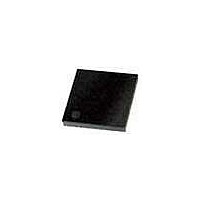PIC18F44K20-E/MV Microchip Technology, PIC18F44K20-E/MV Datasheet - Page 145

PIC18F44K20-E/MV
Manufacturer Part Number
PIC18F44K20-E/MV
Description
16KB, Flash, 768bytes-RAM, 36I/O, 8-bit Family,nanowatt XLP 40 UQFN 5x5x0.5mm TU
Manufacturer
Microchip Technology
Series
PIC® XLP™ 18Fr
Datasheet
1.PIC18F25K20T-ISS.pdf
(456 pages)
Specifications of PIC18F44K20-E/MV
Processor Series
PIC18
Core
PIC18F
Data Bus Width
8 bit
Program Memory Type
Flash
Program Memory Size
8 KB
Data Ram Size
512 B
Interface Type
I2C, SPI, SCI, USB, MSSP, RJ11
Maximum Clock Frequency
64 MHz
Number Of Programmable I/os
35
Number Of Timers
4
Operating Supply Voltage
1.8 V to 3.6 V
Maximum Operating Temperature
+ 125 C
Mounting Style
SMD/SMT
Package / Case
UQFN-40
Development Tools By Supplier
MPLAB Integrated Development Environment
Minimum Operating Temperature
- 40 C
Operating Temperature Range
- 40 C to + 125 C
Supply Current (max)
30 uA
Core Processor
PIC
Core Size
8-Bit
Speed
48MHz
Connectivity
I²C, SPI, UART/USART
Peripherals
Brown-out Detect/Reset, HLVD, POR, PWM, WDT
Number Of I /o
35
Eeprom Size
256 x 8
Ram Size
768 x 8
Voltage - Supply (vcc/vdd)
1.8 V ~ 3.6 V
Data Converters
A/D 14x10b
Oscillator Type
Internal
Operating Temperature
-40°C ~ 125°C
Lead Free Status / Rohs Status
Details
- Current page: 145 of 456
- Download datasheet (4Mb)
11.2
In Capture mode, the CCPRxH:CCPRxL register pair
captures the 16-bit value of the TMR1 or TMR3
registers when an event occurs on the corresponding
CCPx pin. An event is defined as one of the following:
• every falling edge
• every rising edge
• every 4th rising edge
• every 16th rising edge
The event is selected by the mode select bits,
CCPxM<3:0> of the CCPxCON register. When a cap-
ture is made, the interrupt request flag bit, CCPxIF, is
set; it must be cleared by software. If another capture
occurs before the value in register CCPRx is read, the
old captured value is overwritten by the new captured
value.
11.2.1
In Capture mode, the appropriate CCPx pin should be
configured as an input by setting the corresponding
TRIS direction bit.
11.2.2
The timers that are to be used with the capture feature
(Timer1 and/or Timer3) must be running in Timer mode
or Synchronized Counter mode. In Asynchronous Coun-
ter mode, the capture operation may not work. The timer
to be used with each CCP module is selected in the
T3CON register (see Section 11.1.1 “CCP Modules
and Timer Resources”).
11.2.3
When the Capture mode is changed, a false capture
interrupt may be generated. The user should keep the
CCPxIE interrupt enable bit clear to avoid false inter-
rupts. The interrupt flag bit, CCPxIF, should also be
cleared following any such change in operating mode.
11.2.4
There are four prescaler settings in Capture mode; they
are specified as part of the operating mode selected by
the mode select bits (CCPxM<3:0>). Whenever the
CCP module is turned off or Capture mode is disabled,
the prescaler counter is cleared. This means that any
Reset will clear the prescaler counter.
Switching from one capture prescaler to another may
generate an interrupt. Also, the prescaler counter will
not be cleared; therefore, the first capture may be from
a non-zero prescaler. Example 11-1 shows the
recommended method for switching between capture
prescalers. This example also clears the prescaler
counter and will not generate the “false” interrupt.
2010 Microchip Technology Inc.
Note:
Capture Mode
CCP PIN CONFIGURATION
If the CCPx pin is configured as an output,
a write to the port can cause a capture
condition.
TIMER1/TIMER3 MODE SELECTION
SOFTWARE INTERRUPT
CCP PRESCALER
EXAMPLE 11-1:
PIC18F2XK20/4XK20
CLRF
MOVLW
MOVWF
CCP2CON
NEW_CAPT_PS ; Load WREG with the
CCP2CON
CHANGING BETWEEN
CAPTURE PRESCALERS
(CCP2 SHOWN)
; Turn CCP module off
; new prescaler mode
; value and CCP ON
; Load CCP2CON with
; this value
DS41303G-page 145
Related parts for PIC18F44K20-E/MV
Image
Part Number
Description
Manufacturer
Datasheet
Request
R

Part Number:
Description:
Manufacturer:
Microchip Technology Inc.
Datasheet:

Part Number:
Description:
Manufacturer:
Microchip Technology Inc.
Datasheet:

Part Number:
Description:
Manufacturer:
Microchip Technology Inc.
Datasheet:

Part Number:
Description:
Manufacturer:
Microchip Technology Inc.
Datasheet:

Part Number:
Description:
Manufacturer:
Microchip Technology Inc.
Datasheet:

Part Number:
Description:
Manufacturer:
Microchip Technology Inc.
Datasheet:

Part Number:
Description:
Manufacturer:
Microchip Technology Inc.
Datasheet:

Part Number:
Description:
Manufacturer:
Microchip Technology Inc.
Datasheet:










